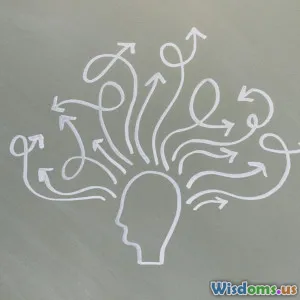
Can You Improve Creativity by Controlling Your Dreams? Here is How
8 min read Explore how mastering lucid dreaming can boost creativity and transform your problem-solving skills. (0 Reviews)
Can You Improve Creativity by Controlling Your Dreams? Here is How
Creativity—the ability to generate novel and valuable ideas—fuels innovation, arts, science, and everyday problem-solving. What if you could tap into a hidden laboratory of creativity right inside your mind? Imagine consciously steering your dreams to unlock deeper imagination and find unexpected solutions.
Welcome to the fascinating world of lucid dreaming, a state where you know you’re dreaming and can actively control the narrative of your dreams. Emerging research and anecdotal evidence suggest lucid dreaming can be a powerful tool for boosting creativity. This article delves into how controlling your dreams can unlock creative potential, the science behind it, and practical methods to harness this remarkable ability.
Understanding Lucid Dreaming: The Gateway to Controlled Creativity
Lucid dreaming occurs during Rapid Eye Movement (REM) sleep when dreamers become aware that they are dreaming. Unlike regular dreams where the experience is passive, lucid dreamers can influence the plot, settings, and characters.
Scientific Basis
One landmark study by Dr. Ursula Voss and colleagues (2014) using EEG brain imaging revealed that lucid dreaming blends brain features of wakefulness and REM sleep. The prefrontal cortex, associated with self-awareness and higher cognitive function, becomes more active than in normal dreaming. This hybrid state enables reflection and volitional control, critical to creative problem-solving.
Creativity in Sleep
Dreams have long been linked to creativity—from Paul McCartney composing "Yesterday" after a dream to Nobel laureate Otto Loewi’s dream-inspired experiment validating neurotransmitters. However, the difference with lucid dreaming is the ability to direct these creative processes intentionally.
How Controlling Dreams Enhances Creativity
1. Access to Unfettered Imagination
Dreams bypass waking brain constraints such as logic and sensory input limitations, freeing imagination. By steering dreams, creators expand this playground rather than just being passive visitors, enabling the generation of novel ideas and artistic inspiration.
For instance, Salvador Dalí reportedly practiced entering hypnagogic states to manipulate his dream imagery, contributing to his distinctive surreal artworks.
2. Problem-Solving in a Safe Experimental Space
Dreams allow experimentation without real-world consequences. Lucid dreamers can simulate risks, explore alternative solutions, or visualize abstract concepts.
Timothy Leary famously used lucid dreaming indigenous to Tibetan yogic traditions to enhance problem-solving, demonstrating how this could accelerate scientific and artistic breakthroughs.
3. Emotional Insight and Creativity
Controlling dreams can help navigate emotional blocks or mental barriers, allowing unconscious material to surface and resolve. Such emotional processing can foster authenticity and depth in creative output.
Practical Techniques to Cultivate Lucid Dreaming for Creativity
Reality Testing and Dream Journals
Regular reality checks during the day (e.g., pinching your nose and attempting to breathe) train your brain to question reality, increasing chances of recognizing a dream.
Keeping a detailed dream journal improves dream recall and helps identify recurring patterns, making lucid dreaming easier and more predictable.
The Mnemonic Induction of Lucid Dreams (MILD)
Before sleep, repeat an intention like "Next time I’m dreaming, I will realize I’m dreaming." This technique, developed by Dr. Stephen LaBerge in the 1980s, is one of the most effective induction strategies.
Wake Back to Bed (WBTB)
Wake yourself up after 5-6 hours sleep, stay awake briefly, then return to sleep with focused intent to become lucid. This exploits the longer REM periods toward morning.
Use of Technology
Devices like lucid dream masks that detect REM sleep and provide auditory or visual cues can trigger lucidity without full awakening.
Real-World Success Stories and Evolution
Artists and Writers
Writer Neil Gaiman has spoken publicly about harnessing lucid dreams to overcome writer’s block and gather symbolic narratives, while musician Pharrell Williams credits dreams for some of his innovative hooks.
Researchers and Innovators
Dream incubation experiments have led scientists to unconventional solutions, such as Elias Howe’s invention of the sewing machine’s lockstitch after a dream about cannibals using spears with holes.
Challenges and Ethical Considerations
Not everyone can lucid dream reliably; it demands patience and discipline. Overemphasis on controlling dreams might induce sleep disturbances or mental fatigue.
Moreover, the boundary between lucid dreaming and waking life blurs for some individuals, which could complicate mental health conditions.
Conclusion: The Creative Frontier Awaits Within
Controlling your dreams offers a profound, underexplored path to harnessing creativity. By intentionally interacting with your subconscious, you open doors to novel ideas, problem-solving abilities, emotional insights, and a laboratory of imagination unfettered by waking limitations.
While research is still unfolding, the blend of neuroscientific evidence and inspirational personal accounts presents a compelling case to embark on lucid dreaming as a creativity enhancer.
Whether you’re an artist, inventor, writer, or dreamer curious about the mind’s potential, adopting lucid dreaming practices might just transform how you think, create, and innovate. Begin with small steps—record your dreams, practice reality checks, and nurture the lucidity muscle—and prepare to enter a world of creative possibilities you’ve only dreamed about.
“Dreams feel real while we’re in them. It’s only when we wake up that we realize something was actually strange.” — Christopher Nolan
Embrace the strangeness. Control your dreams, and let them fuel your creative journey today.
References
- Voss, U., Holzmann, R., Tuin, I., & Hobson, J.A. (2014). Lucid dreaming: a state of consciousness with features of both waking and non-lucid dreaming. Sleep, 37(9), 1637-1649.
- LaBerge, S. (1985). Lucid Dreaming. Ballantine Books.
- Barrett, D. (2001). The “Committee of Sleep”: A Study of Dream Incubation for Problem Solving. Dreaming, 11(2), 115-124.
- Nielsen, T. A., & Stenstrom, P. (2005). What are the memory sources of dreaming? Nature, 437(7063), 1286-1287.
Rate the Post
User Reviews
Popular Posts




















